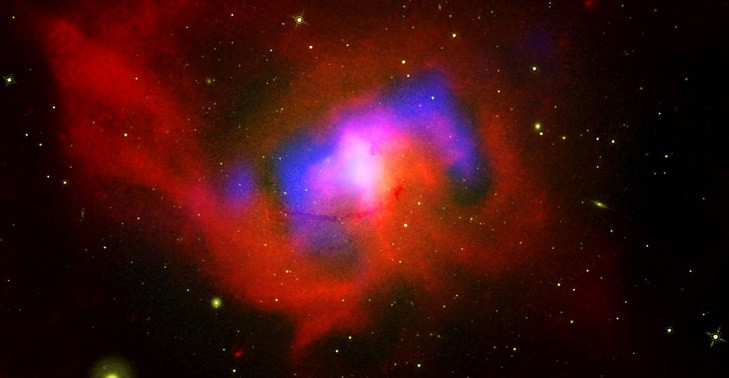NASA lens captures the moment of
The new information shows that a giant black hole can push matter into the subject Milky Way, a phenomenon that many people associate with a beating heart pumping blood to the body.

The heart of the black hole is 145 million light-years away from Earth, pushing matter into space.
According to RT TV, the NASA Space Telescope's telescope recorded the image from NGC 4969 black hole in the Milky Way, 145 million light-years from Earth.
Scientists while examining data obtained from Chandra X-ray observation telescopes have found repeated repetitions of synthetic energy particles in black holes. Later, these energy particles are in the form of hot gases, creating holes in the space that resemble the shape of the heart cavity.
The cycle between energy launches is between 5 and 10 million years, and each time a black hole is released, a strong wave causes energy particles to travel tens of thousands of light years away.
This phenomenon is thought by many to be the contraction of the heart in the process of pumping blood throughout the body through arteries.
- Lens turns 'cricket' into a microscope
- NASA ships eclipse photos of Jupiter
- Former NASA astronaut participates ... playing in a gravityless environment
- Camera lens is 2,000 times thinner than human hair
- Multifocal lens for 3D microscope
- Video 73000 FPS captures the moment when bullets come out of the barrel
- Touching the moment the cat is determined to pull your body to safety
- NASA captures a star image
- Prevent cataracts
- Prizes for beautiful wild photos
- The telescope finds out the first moment of the universe
- Canon successfully developed a camera lens capable of self-cleaning dust
 Van Allen's belt and evidence that the Apollo 11 mission to the Moon was myth
Van Allen's belt and evidence that the Apollo 11 mission to the Moon was myth The levels of civilization in the universe (Kardashev scale)
The levels of civilization in the universe (Kardashev scale) Today Mars, the sun and the Earth are aligned
Today Mars, the sun and the Earth are aligned The Amazon owner announced a secret plan to build a space base for thousands of people
The Amazon owner announced a secret plan to build a space base for thousands of people Black holes create mysterious swirling 'structures' that could open 'gateways' into dark matter
Black holes create mysterious swirling 'structures' that could open 'gateways' into dark matter  Surprising facts about the black panther - the inspiration for the character Black Panther
Surprising facts about the black panther - the inspiration for the character Black Panther  The nearest black hole discovered is only 150 light years from Earth
The nearest black hole discovered is only 150 light years from Earth  New discovery of the oldest black hole in the universe
New discovery of the oldest black hole in the universe  The Black Pyramid and the tragedy of deep oblivion: A thousand years later, still no escape from the tragedy of tomb raiding
The Black Pyramid and the tragedy of deep oblivion: A thousand years later, still no escape from the tragedy of tomb raiding  Exploring the 'Black Box of the Earth' project: A device that records the process of human extinction
Exploring the 'Black Box of the Earth' project: A device that records the process of human extinction 